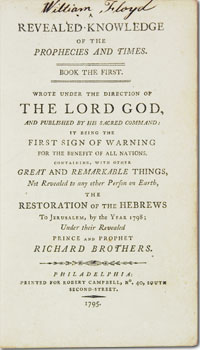
The Cedar Swamp Historical Society's collection contains a rare and important book entitled, A Revealed Knowledge of the Prophecies
and Times, written by Richard Brothers and signed by William Floyd, New York's delegate to the First Continental Congress in
Philadelphia and a signer of the Declaration of Independence. A resident of Mastic, Long Island for a time, Floyd became involved in
politics through his interest in fighting for the rights of the people. He remained in the Congress until 1783 and also served as a state
senator. Floyd's signature can be found in Brothers' book on the front free endpaper and title page of the book.
Richard Brothers was a Canadian who moved to England to serve in the navy. After his service, he began to envision that he, as a
descendent of King David, was the receiver of prophecies sent to him by God. He wrote about his apocalyptic visions in his book,
A Revealed Knowledge of the Prophecies and Times which was published in 1794. He wrote of his conviction that as the creator
of the idea of British-Israelism, (a belief that the British were the direct descendants of the lost tribes of Israel), he was destined to
lead the lost tribes of Israel back to Palestine. He also wrote that the "hidden Jews" of Britain would gather together at the time of
the next millennium, an event which he claimed would begin on November 19, 1795.
Brothers' writings gained him a following within England, France and America. Because his prophecies came at a time when England was
involved in fighting with the French revolutionaries and having domestic problems the volatile conditions of the period led some
people to accept his visions as true. Consequently, British authorities became concerned with Brothers' growing influence and under the direction of King George III, they decided to arrest him and place him into an asylum. His importance then waned and he died without regaining his fame.
Brothers' book was popular on both sides of the Atlantic and this would probably explain William Floyd's ownership of it.
Bibliography
T. Stunt, "Brothers, Richard (1757-1824)", Oxford Dictionary of National Biography, Oxford University Press,
2004, available at http://www.oxforddnb.com/view/article/3573 [accessed 30 Sept 2005]; "Richard Brothers, the Placentia Prophet",
Placentia, the Early Years, Canada's Digital Collections, available at http://collections.ic.gc.ca/placentia/rbroth.htm
[accessed 23 September 2005]; "Richard Brothers and the Millennium", Pharos, The Fitzwilliam Museum, Cambridge, England,
available at http://www.fitzmuseum.cam.ac.uk/pharos/collection_pages/18th_pages/P344_1948/FRM_TXT_SE-P344_1948.html
[accessed 23 September 2005]; C. Oakley. The Heritage of Long Island, New York, 1970; V. Dyson, The Human Story of
Long Island, New York, 1969; "The William Floyd Estate", Fire Island National Seashore, National Parks Service, U. S.
Department of the Interior,
available at http://www.nps.gov/fiis/Wfe/wfe.html [accessed 26 September 2005]; George DeWan, "They Signed
for Independence" Long Island, Our Story, Newsday, 2005, available at
http://www.newsday.com/community/guide/lihistory/ny-history-hs426a,0,6830018.story?coll=ny-lihistory-navigation
[accessed 30 September 2005].
|

